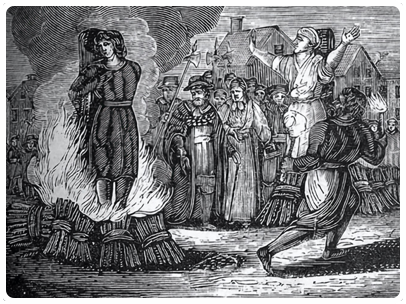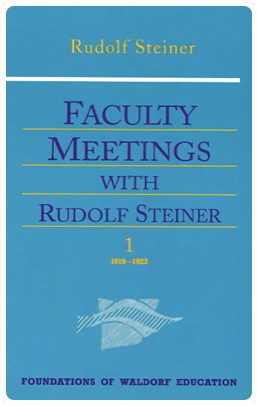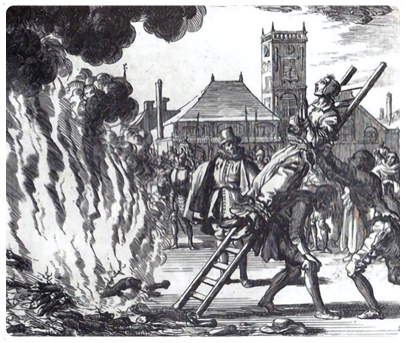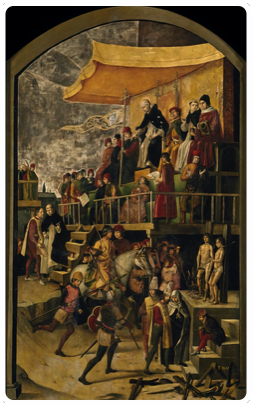Witch-Hunts & Excommunications
How Steiner-Waldorf Communities Sever Ties

Steiner-Waldorf schools appear to go to great lengths to make it look as if anyone leaving did so of their own accord, and it's only after having exhausted all other avenues that they formally "ask them to leave".
We saw it with a single mother at the Titirangi Rudolf Steiner School. We hardly knew her and only started communicating with her after she suddenly took her children out of the school. It was only then that we learned that she'd spent the last five years trying to deal with the terrible unchecked bullying her son was being subjugated to (something the school had never told us she was going through even though our child was facing the same issue, in the same class).
Once she'd gone, the rumour mills started churning; there was something wrong with the mother, she kept shaking all the time, Steiner wasn't a good fit for her or her children, etc. It seems it was important for the community to distance itself from her and reassure itself that her decision to leave had nothing to do with any action or inaction of the school. The fact that she'd been part of that community for five years had no bearing on the rumours; the problem was with her and her abnormal mental state.
We ourselves experienced what can happen when a school targets a family after the axe incident. At school drop-off, the day the expulsion letter was written, manager Mark Thornton looked agitated, briskly going from class to class. In retrospect, we suspect he was covertly discussing the situation with individual members of the College of Teachers before making the expulsions official, as per Perra's account below.
Once out of the school, the rumour mills churned once more, and the situation was made worse when Mark Thornton co-organised a meeting where the parents of our eldest daughter's class were encouraged to spread the vilest unsubstantiated allegations about us. All to place the blame squarely at our feet and exonerate the school.
We also learnt that this action isn't solely reserved for families: teachers can be targeted as well. A parent from the Te Ra Waldorf school told us that “one of the teachers had the same experience as you, where he was not invited to a meeting, he was then talked about badly to his class and the wrong reason for him resigning was given. This is obviously a tactic! One with very painful repercussions for those involved.”
It's clear that this type of behaviour isn't an isolated incident confined to a single school community or even a single country: according to Grégoire Perra, the reason Steiner-Waldorf schools behave this way may well stem from how the very first dismissal of a teacher from a Steiner-Waldorf school was handled by Rudolf Steiner himself:

Dr. Steiner: we have the personnel problem. The problem is that our present shop teacher has not done what we expected, so we need to think of a replacement.[…] I am not certain to what extent you are familiar with the problem […]
A teacher: Is there a reason we would need to get rid of him or could we employ him somewhere else, for example in the library?
Dr. Steiner: It is certainly difficult to make a clear decision. I think it will be difficult for him to find his way into the real spirit of the school because he hasn’t the spirit in him. […] He has poetic ambitions, but he imagines himself to be much better than he is. He has a wonderful amount of goodwill. I feel sorry for him because I think he will probably develop a lot of resentment. […] In an area where objectivity is necessary, it is very difficult when sympathy plays a role. […] I had the impression that was the opinion of the whole faculty. At the beginning, I thought this was already decided, but now I see that is not so. It is good we have discussed the matter so that we all understand it.
(Extract taken from “Faculty Meetings With Rudolf Steiner”, Pages 149-152)
We’ve translated Perra's explanation of this quote. It clarifies why such attacks appear to be de rigeur among staff and school communities alike, and how absolutely devastating they can be: “The way in which this dismissal took place is most interesting, as it reveals characteristic traits of Waldorf's pedagogy.
“Firstly, Rudolf Steiner begins by announcing a decision which he believes has already been made, starting with a pre-validated statement ("we need to think of a replacement”). However, none of the previous meetings appear to have been devoted to this problem. We have to conclude that the matter was discussed walking down corridors, between various people who took the decision without consulting others. These people now want their decision endorsed. "I am not certain to what extent you are familiar with the problem”: everything appears to have been decided on the sly. And then the rumours of this dismissal appear to have spread throughout the school.
“Indeed, according to my own experience, this is often the way dismissals are decided in Steiner-Waldorf schools: a handful of very influential and highly placed teachers decide among themselves, speak to others in order to convince them, and only bring the proposal to the College of Teachers once they are certain the motion will be carried. Sometimes, the rumour reaches the ears of that particular teacher prior to the decision having been acted upon, throwing them into a frightful state of distress.
“We then witness Rudolf Steiner laying out the reasons why dismissal is necessary, which are odd to say the least. Steiner begins by explaining that although this teacher has invested a lot of himself in his class, and has devoted his heart and soul to his students, he lacks sufficient artistic capabilities.
“Up to this point, it’s possible to follow this reasoning, even though it may appear to be harsh (in fact, some members of the College appear to be incredulous of the reason given).

“But afterwards, Steiner moves on to judge this teacher’s personality and spirituality. He begins by stating that this person doesn’t apply himself properly to the spirit of the school because "he hasn’t the spirit in him". Therefore, for Steiner, being a teacher in a Steiner-Waldorf school doesn’t solely depend on your capabilities, nor does it depend on your belief in anthroposophy. As we can see, being a Steiner-Waldorf teacher touches on some kind of spiritual anointing. A teacher must have "the spirit in him"! In a similar way to the first Christians receiving the Holy Spirit through baptism, Steiner-Waldorf teachers must receive (either through pedagogical teachings, or anthroposophical lectures) the spiritual anointing of cosmic entities which overshadow this "pedagogy".
“Evidently, this can lead to witch-hunts once a teacher finds themselves, for whatever reason, in their colleagues’ line of fire. You would have to have been witness to one of these meetings of the Internal College, to understand how some of these gatherings, whose agenda is to decide on the dismissal of a colleague, can quickly turn into an inquisitorial tribunal. The meeting then takes on the appearance of an ecclesiastical assembly about to perform some sort of excommunication.

“The worst things are said concerning the person about to be fired, to the point that the picture being drawn of them is sometimes akin to that of being possessed, capable of spiritually damaging the school’s entity. Here, Anthroposophists merely follow their natural tendency, which is the systematic judgement of others. But within a professional context, this affinity for scandal becomes a scourge! Carried away by a collective swell of hatred, each one will draw from their spiritual lucubration to condemn the designated teacher.
“Having decided whether or not the teacher possesses the "spirit of the school”, they move on to judge their lifestyle choice and their personality, just like Steiner did himself: "he has poetic ambitions, but he imagines himself to be much better than he is.” The most intimate parts of their private life can be revealed during this gathering, without the slightest remorse or restraint! Rudolf Steiner’s words, as shown in the above extract, in which “sympathy” shouldn’t be taken into account when deciding on a teacher's fate, are taken at face value. They enable some to abandon any kind of decency in their accusations.
“But the worst is yet to come when the Internal College then “invites” the colleague in question, to reveal to them its decision. That session often turns into a lynching!
“I’m going to describe events as they have been disclosed to me by former colleagues who were the targets of them. I must categorically stress that this did not happen in my case.
“The person in question arrives, without really knowing what the complaint will be about, since they never received any official notification. In most cases they will be on their own, surrounded by all the members of the Internal College who can number up to a dozen. The subject is made to sit in the far side of the room, so that once all the other teachers are seated, they physically block access to the way out.
“After a brief preamble designed to put the subject at their ease, the hostilities begin: each teacher incriminates the accused in turn. Initially, the teacher tries to defend themselves, arguing in their defence. But slowly, faced with increasingly worse allegations which focus on the most intimate parts of their personality, without any respite, they can do nothing but collapse in tears.

“This is when the intensity of these attacks increases. This process can last for hours! A kind of collective madness takes hold of the College of Accusers, in a way similar to a scene from Arthur Miller's The Crucible. No one will step in to calm the situation down. The College President, whose position includes keeping control of the meeting, remains silent in most cases. He knows that if he intervenes, he may well be next in line for the chop.
“The teacher lies broken, psychologically destroyed for the long term. After this treatment, they often choose to offer their resignation. Their will having been annihilated.
“But if this wasn’t sufficient, if the teacher stubbornly decides to remain, they are reconvened. Sometimes the "separation process" (that is the term used) can last for months and spread over dozens of similar gatherings, either with the entirety of the Internal College, or through a special commission.
“At times, the aim of this repeated psychological torture isn't to get the teacher to resign: it simply becomes a means for the Internal College to reassert its authority when it feels challenged. Numerous teachers are then summoned to face this trial. As the members of the "Internal College" or "College of Direction" can change in just a few years, a teacher who had previously suffered from this type of treatment can later find themselves alongside the accusers, instantly adopting the same behaviour, becoming even more ferocious, the more humiliated he had felt when he had once been the focus of such attacks.
“Reading Rudolf Steiner's interventions during the meeting of the 30th of July 1920, it's clear how such monstrous behaviour could've seen the light of day. It was pretty much unavoidable. It is certainly regrettable that Rudolf Steiner didn't possess the professional ethics that would've refrained him from passing judgment on the fact that this teacher enjoyed writing poetry. This was strictly a private matter which should never have been brought up during a meeting. His verdict that, according to him, this teacher didn't have "the spirit in him", can also be seen as deplorable.
“Without such attacks, it is possible the example set by the Master would've been less harmful. Yet I believe that similar abuse would have surfaced regardless. In a Steiner-Waldorf school, where confusion between being an educational institution and a religious movement is the norm, the job of a Steiner-Waldorf teacher becomes some kind of priesthood. Not only should they possess teaching expertise, they must also have been anointed by the Spirit, and must carry that within themselves. They mustn't simply try to integrate within a educational team, they must strive to belong in a spiritual community.
“This logically leads to "witch-hunts" once it is necessary to let someone go. Yet this type of excommunication can destroy an individual who has devoted their lives to the anthroposophical system of beliefs, who shows a deep faith in their pedagogical vocation in service of a Steiner-Waldorf institution, and who has bound themselves to their school because of the nature of the community it offers, which is more emotional than professional. Steiner knew this, which is why he said the teacher "will probably develop a lot of resentment.", to the point that he may become an "enemy of the school".”
The most striking part of Perra's account is seeing the lengths a school will go to to vilify a person it no longer views as desirable. Although he refers to situations involving teachers, most of the methods described feel very similar to how too many families have been treated, either by staff members, the community, or both.
This would explain the number of families who leave in disgust while the school puts on an innocent face and says it isn't responsible for what happened. How can an education system which treats people in this way genuinely claim to offer a "safe, peaceful, and natural learning haven"?
The Steinermentary Project was launched with a poster campaign asking the question, "is Steiner education putting children at risk?". The aggression aimed at those posters, the testimonials of people who have shared their stories with us, and the ongoing revelations about what lies beneath the beautiful surface, keeps this question as relevant today as it has ever been.
The image of the burning at the stake was taken from Our Bully Pulpit;
The image of the burning of a 16th-century Dutch Anabaptist was taken from Wikipedia;
Pedro Berruguete’s painting of Saint Dominic Presiding over an Auto da Fe was taken from Wikipedia;
The painting of Pope Gddregory VII excommunicating Emperor Henry IV was taken from Wikipedia.


